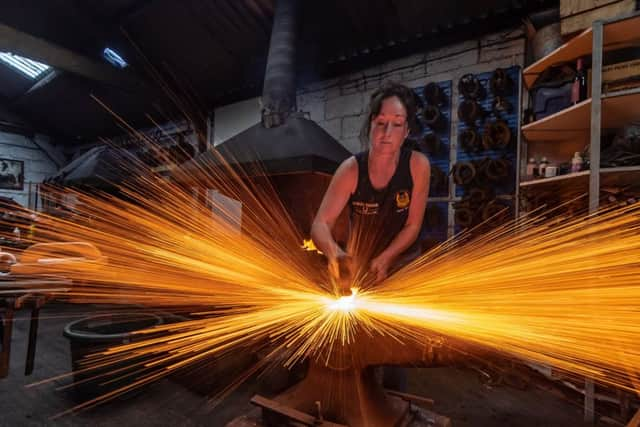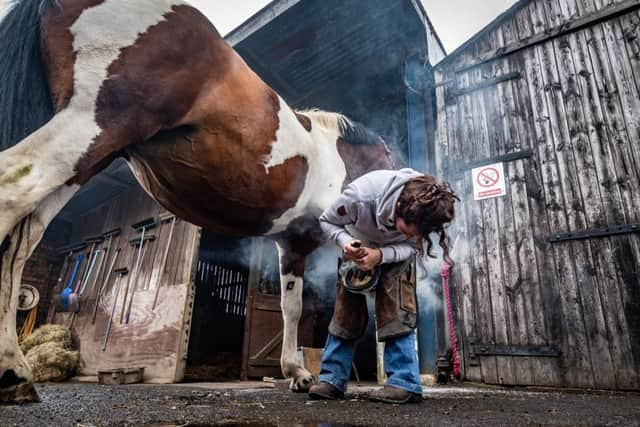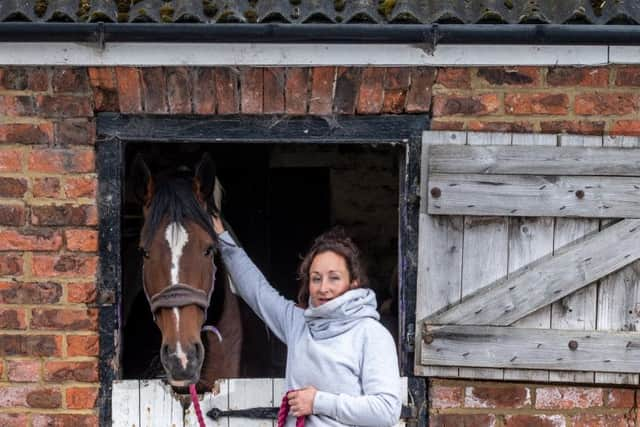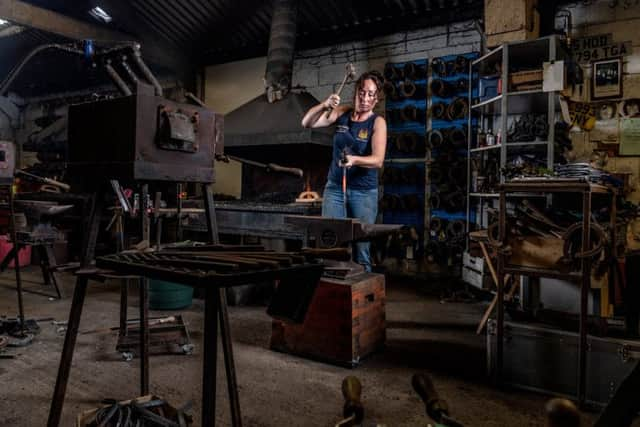Meet North Yorkshire’s Sarah-Mary Brown - the only female master farrier in the country
Under the spreading chestnut tree a village smithy stands; The smith, a mighty man is he ... (with ) arms like iron bands.”
So starts Henry Wadsworth Longfellow’s poem The Village Blacksmith – written over a decade before he penned The Song of Hiawatha.
Advertisement
Hide AdAdvertisement
Hide AdThat’s village blacksmiths. From York to Yeovil and beyond, they’ve forever been the stuff of legend. Displaying Falstaffian beer bellies in leather aprons, they historically make cast-iron anvils ring while walloping glowing horseshoes.


Sarah-Mary Brown is a modern day incarnation of another of those most ancient of crafts – a farrier – and one who completely breaks the mould.
Horses and ponies spring to mind as I take in the view from her kitchen, with emerald fields stretching out towards the A19 near the picturesque village of Crathorne in North Yorkshire. “Good farrier country?” says Sarah, reading my mind with a slight Glaswegian twang.
I mention Longfellow’s village blacksmith. Sarah clarifies the difference between blacksmiths and farriers: the first being metal workers who specialise in wrought-iron work; the latter shoeing horses and treating equestrian feet ailments. She sees herself as a farrier rather than a blacksmith.
Advertisement
Hide AdAdvertisement
Hide AdBeing a farrier is a highly-skilled craft – the Worshipful Company of Farriers, which had been established in 1356 by the Mayor of London, was granted a Royal Charter in 1674 by King Charles II.


It’s a skill that not many people attain and in 2011, when she was named an Associate of the Worshipful Company of Farriers (WCF), Sarah became only the second woman in 650 years to be recognised as an elite farrier.
Associates of the WCF, she says, focus on the “different pathologies and diseases of feet”, a subject close to her heart as we’ll come to later.
Sarah went one better four years ago by becoming the first-ever female Fellow of the WCF, publishing a scientific thesis and excelling in lecturing skills. “So, it’s Sarah-Mary Brown FWCF then?” I ask. She nods.
Advertisement
Hide AdAdvertisement
Hide AdSure enough after Googling “WCF” I spot her name, the solitary female presence in the impressive list of UK master farriers.


Across the yard is a smithy. Her van is adjacent equipped with anvil, propane gas-powered forge and tools.
She hot-shoes, she says proudly, “a really nice mixture of horses”. Cobs, Clydesdales, Shires, Shetlands and “a lot of very good show horses and eventing ponies,” she adds for good measure.
Eventing horses are cold shod. She fits feather-weight aluminium shoes that are less likely to restrict movement.
Advertisement
Hide AdAdvertisement
Hide AdSo how much does it cost to shoe a pony? Sarah estimates £70 to £75. For a Clydesdale about £150. It takes on average between five and eight weeks before hooves need re-shoeing.


Hot-shoeing means burning onto the hoof the red-hot glowing horseshoe plucked with tongs from the forge and shaped with her 7lbs sledge on the anvil – along with dense, acrid and cloying smoke.
People once registered surprise when she turned up. But it is less unusual to see a female farrier these days. Registrations by female farriers have increased by 70 per cent in recent years for a career that has traditionally been viewed as being exclusively male.
Today, there are more than 3,000 male farriers and 75 female compatriots. “Women with a passion for shoeing horses are showing a real talent,” she says. “Being a farrier is a fantastic job, even though it is hard sweat. Horses can kick you, lean on you, or bite you as you stoop to shoe their front feet, even lash you with their tails.”
Advertisement
Hide AdAdvertisement
Hide AdSo how does she prevent the latter? “I bandage their tails up the humane way. Horses weighing up to a tonne can deliberately stand on one of your work boots as you shoe them, either being playful or bloody-minded.”
The ultimate hazard is when a horse raises up in mid-shoeing on their back legs. “I suffer from back ache,” she says. “A horse reared up backwards. It sent me flying onto a concrete floor. I had been holding one of its front legs between my legs as I worked. Suddenly it threw me over my tool box on to a hip, putting my back out at its base,” she says.
“What did I do? Just tied the horse back up, gritted my teeth and started over again.”
Her fingers are calloused, the result of seizing glowing-hot mild steel bars from the forge with tongs and beating them on the anvil into the shape of horseshoes.
Advertisement
Hide AdAdvertisement
Hide AdHer dentist warns the time-honoured farrier habit of gripping seven horseshoe nails at a time between her teeth while shoeing horses is not a good idea as they can chip front teeth.
Instead, she now holds the nails in her mouth, turning her lips black from the copper coating. “It washes away,” she says, brushing my concern aside, adding that no, she hasn’t swallowed a nail yet.
Her journey to this point has been a fascinating one. Growing up on Glasgow’s south side, her careers officer tried to put her off becoming a farrier, saying it was “unladylike”. Her steely eyes flash as she remembers this response.
Her parents – her mother was a teacher and her father a plumber – encouraged her. At the age of 14 she worked at local stables, watching fascinated as a visiting farrier shod horses, a “real gent” called Jock Weir.
Advertisement
Hide AdAdvertisement
Hide Ad“Why doesn’t hammering nails into horse’s hooves hurt?” was just one of her many questions. His reply? “A hoof is made of horn like toenails. There’s no pain unless you accidentally hit a nerve. It should never happen.”
Encouraged by his advice to go for it, she subsequently attended Oatridge Agricultural College in East Lothian and served a four-year apprenticeship.
She followed this up by hand writing 300 job applications, only striking lucky when a “top-notch” farrier called Derek Gardner in Penrith took her on in 2001.
During her apprenticeship she competed – as indeed she still does – in shoeing events at country shows including the Great Yorkshire Show and Kilnsey Show (sadly now minus its shoeing contest under its top-heavy crag).
Advertisement
Hide AdAdvertisement
Hide AdSignificant among these are four annual events run by The Yorkshire Farriers Association: Topcliffe, Otley, Londonderry and Countryside Live at the Great Yorkshire Showground in Harrogate.
Early on during these fiercely contested events she met her future husband, Steven. “He’d recently qualified as a farrier and so was four years ahead of me in training,” she says.
The upshot was she closed down a farrier business she had initially launched in Cumbria, and moved to North Yorkshire where Steven had his business up and running.
Today they share his smithy at Manor Cottage Farm, but run their enterprises as two quite separate businesses, each with their own vans for mobile shoeing.
Advertisement
Hide AdAdvertisement
Hide AdThey married, not over the anvil in Gretna Green’s famed Blacksmith’s shop, but in Glasgow in 2014, with ribbons decorating horseshoes on the tables.
As I leave she tells me of a forthcoming challenge: to shoe a 10-week-old foal born with twisted legs. She has to glue remedial shoes on that will correct the imbalance over time.
“They persuade the foal to stand the correct way as they’re built up on one side to correct faulty posture,” she explains.
Sounds miraculous. Had she done this successfully before? “Time and again,” she says. “The best part of a farrier’s work. Putting something right as Mother Nature intended.”
It must be very satisfying, I say. “Oh, it is, very much so... God’s gift.”